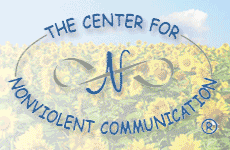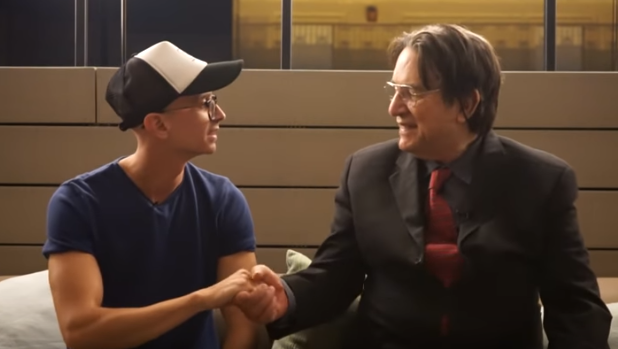Nonviolent Communication: Simple, Powerful Technique to Transform Your Relationships
Click to teach Gmail this conversation is important.
Join many informed, caring subscribers from around the world
Subscribe here to one of our two email lists
PEERS: Inspiration and Education for a Transformed World
This message is also available at this link.
A Concise Guide to Nonviolent Communication
Dear friends,

Nonviolent communication (NVC) is one of the most powerful tools available for transforming our lives and world. The below summary provides a concise explanation and easy-to-follow instructions for how to use these techniques to better manage interpersonal conflicts that come up in your life.
I highly recommend before reading the summary below that you watch the inspiring 10-minute video of NVC founder Marshall Rosenberg available here. These principles have been incredibly helpful to me in dealing with challenging relationship situations in my life.
Note: Marshall Rosenberg sadly died of prostate cancer on Feb. 7, 2015.
Nonviolent Communication Primer
By Inbal and Miki Kashtan
Introduction to Nonviolent Communication
Nonviolent Communication (NVC) has been described as a language of compassion, as a tool for positive social change. NVC gives us the tools to understand what triggers us, to take responsibility for our reactions, and to deepen our connection with ourselves and others, thereby transforming our habitual responses to life. Ultimately, it involves a radical change in how we think about life and meaning.
Nonviolent Communication is based on a fundamental principle: Underlying all human actions are needs that people are seeking to meet. Understanding and acknowledging these needs can create a shared basis for connection, cooperation, and more harmonious relationships on both a personal and global level. Understanding each other at the level of our needs creates this possibility because, on the deeper levels, the similarities between us outweigh the differences, giving rise to greater compassion.
When we focus on needs – without interpreting or conveying criticism, blame, or demands – our deeper creativity flourishes, and solutions arise that were previously blocked from our awareness. At this depth, conflicts and misunderstandings can be resolved with greater ease.
The language of Nonviolent Communication includes two parts: honestly expressing ourselves to others, and empathically hearing others. Both are expressed through four components - observations, feelings, needs, and requests – though observations and requests may or may not be articulated.
Practicing NVC involves distinguishing these components from judgments, interpretations, and demands, and learning to embody the consciousness embedded in these components. This compassionate approach allows us to express ourselves and hear ourselves and others in ways more likely to foster understanding and connection. It allows us to support everyone involved in getting their needs met, and to nurture in all of us a joy in giving and in receiving.
The practice also includes empathic connection with ourselves - "self-empathy." The purpose of self-empathy is to support us in maintaining connection with our own needs, thus encouraging us to choose our actions and responses based on self-connection and self-acceptance.
NVC was developed by Dr. Marshall B. Rosenberg, who has introduced it to individuals and organizations world-wide. It has been used between warring tribes and in war-torn countries; in schools, prisons, and corporations; in health care, social change, and government institutions; and in intimate personal relationships. Hundreds of certified trainers and many more non-certified trainers around the world are sharing NVC in their communities.
The Components of Nonviolent Communication
1. Observations
Observations are what we see or hear that we identify as the stimulus to our reactions. Our aim is to describe what we are reacting to concretely, specifically and neutrally, much as a video camera might capture the moment. This helps create a shared reality with the other person. The observation gives the context for our expression of feelings and needs.
The key to making an observation is to separate our own judgments, evaluations or interpretations from our description of what happened. For example, if we say: "You're rude," the other person may disagree, while if we say: "When you walked in you did not say hello to me," the other person is more likely to recognize the moment that is described.
When we are able to describe what we see or hear in observation language without mixing in evaluation, we raise the likelihood that the person listening to us will hear this first step without immediately wanting to respond, and will be more willing to hear our feelings and needs.
Learning to translate judgments and interpretations into observation language moves us away from right/wrong thinking. It helps us take responsibility for our reactions by directing our attention to our needs as the source of our feelings, rather than to the faults of the other person. In this way, observations – paving the way towards greater connection with ourselves and with others – emerge as a crucial building block towards more meaningful connection.
2. Feelings
Feelings represent our emotional experience and physical sensations associated with our needs that have been met or that remain unmet. Our aim is to identify, name and connect with those feelings. The key to identifying and expressing feelings is to focus on words that describe our inner experience rather than words that describe our interpretations of people's actions.
For example: "I feel lonely" describes an inner experience, while "I feel like you don't love me" describes an interpretation of how the other person may be feeling. When we express our feelings, we continue the process of taking responsibility for our experience, which helps others hear what's important to us with less likelihood of hearing criticism or blame of themselves. This increases the likelihood that they will respond in a way that meets both our needs.
A list of feelings to explore is available here.
3. Needs
Our needs are an expression of our deepest shared humanity. All human beings share key needs for survival: hydration, nourishment, rest, shelter, and connection to name a few. We also share many other needs, though we may experience them to varying degrees, and may experience them more or less intensely at various times.
In the context of Nonviolent Communication, needs refer to what is most alive in us: our core values and deepest human longings. Understanding, naming, and connecting with our needs helps us improve our relationship with ourselves, as well as foster understanding with others, so we are all more likely to take actions that meet everyone's needs.
The key to identifying, expressing, and connecting with needs is to focus on words that describe shared human experience rather than words that describe the particular strategies to meet those needs. Whenever we include a person, a location, an action, a time, or an object in our expression of what we want, we are describing a strategy rather than a need.
For example: "I want you to come to my birthday party" may be a particular strategy to meet a need for love and connection. In this case, we have a person, an action, and an implied time and location in the original statement.
The internal shift from focusing on a specific strategy to connecting with underlying needs often results in a sense of power and liberation. We are encouraged to free ourselves from being attached to one particular strategy by identifying the underlying needs and exploring alternative strategies.
Feelings arise when our needs are met or not met, which happens at every moment of life. Our feelings are related to the trigger, but they are not caused by the trigger: their source is our own met or unmet needs. By connecting our feelings with our needs, therefore, we take full responsibility for our feelings, freeing us and others from fault and blame.
And by expressing our unique experience in the moment of a shared human reality of needs, we create the most likely opportunity for another person to see our humanity and to experience empathy and understanding for us.
A list of needs to explore is available here. It is offered as a resource for identifying and experiencing your own needs and guessing others' needs. The needs on this list appear in their most abstract, general and universal form. Each person can find inside herself or himself the specific nuance and flavor of these broader categories, which will describe more fully her or his experience.
4. Requests
In order to meet our needs, we make requests to assess how likely we are to get cooperation for particular strategies we have in mind for meeting our needs. Our aim is to identify and express a specific action that we believe will serve this purpose, and then check with others involved about their willingness to participate in meeting our needs in this way.
In a given moment, it is our connection with another that determines the quality of their response to our request. Therefore, when using NVC, our requests are "connection requests," intended to foster connection and understanding and to determine whether we have sufficiently connected to move to a "solution request."
An example of a connection request might be: "Would you tell me how you feel about this?" An example of a solution request might be "Would you be willing to take your shoes off when you come in the house?" The spirit of requests relies on our willingness to hear a "no" and to continue to work with ourselves or others to find ways to meet everyone's needs.
Whether we are making a request or a demand is often evident by our response when our request is denied. A denied demand will lead to punitive consequences; a denied request most often will lead to further dialogue. We recognize that "no" is an expression of some need that is preventing the other person from saying "yes".
If we trust that through dialogue we can find strategies to meet both of our needs, "no" is simply information to alert us that saying yes to our request may be too costly in terms of the other person's needs. We can then continue to seek connection and understanding to allow additional strategies to arise that will work to meet more needs.
To increase the likelihood that our requests will be understood, we attempt to use language that is as concrete and doable as possible, and that is truly a request rather than a demand. For example, "I would like you to always come on time" is unlikely to be doable, while "Would you be willing to spend 15 minutes with me talking about what may help you arrive at 9 am to our meetings?" is concrete and doable.
While a person may assent to the former expression ("Yes, I'll always come on time"), our deeper needs – for connection, confidence, trust, responsibility, respect, or others - are likely to remain unmet. If someone agrees to our request out of fear, guilt, shame, obligation, or the desire for reward, this compromises the quality of connection and trust between us.
When we are able to express a clear request, we raise the likelihood that the person listening to us will feel that they are given a realistic choice in their response. As a consequence, while we may not gain immediate assent to our wishes, we are more likely to get our needs met over time because we are building trust that everyone's needs matter. Within an atmosphere of such trust, goodwill increases, and with it a willingness to support each other in getting our needs met.
Learning to make clear requests and shifting our consciousness to making requests in place of demands are very challenging skills for most people. Many find the request part to be the hardest, because of what we call a "crisis of imagination" – a difficulty in identifying a strategy that could actually meet our needs without being at the expense of the needs of others.
Even before considering the needs of others, the very act of coming up with what we call a positive, doable request is challenging. We are habituated to thinking in terms of what we want people to stop doing ("don't yell at me"), and how we want them to be ("treat me with respect") rather than what we want them to do ("Would you be willing to lower your voice or talk later?").
With time, and a deeper connection to our needs, our creativity expands to imagine and embrace more strategies. This fourth step in NVC of making a concrete request is critical to our ability to create the life we want. In particular, shifting from demands to requests entails a leap in focus and in faith: we shift from focusing on getting our needs met, to focusing on the quality of connection that will allow both of our needs to truly matter, and ultimately also to be met.
Empathy
Expressing our own observations, feelings, needs and requests to others is one part of Nonviolent Communication. The second part is empathy: the process of connecting with another by guessing their feelings and needs.
Empathic connection can sometimes happen silently, but in times of conflict, verbally communicating to another person that we understand their feelings and that their needs matter to us can be a powerful turning point in problem situations.
Demonstrating that we have such understanding doesn't mean we have to sacrifice our own needs. Connecting empathically with another person can be a catalyst to meeting our needs for understanding, connection, contribution, or others. At the same time, empathy can be a powerful tool to meet the other person's needs. The ability to understand and express the other person's feelings can aid us in finding strategies that meet both of our needs.
The language of NVC often helps us relate with others, but the heart of empathy is in our ability to compassionately connect with our own and others' humanity. Offering our empathic presence, in this sense, is a means through which we can meet our own needs. It is a gift to another person and to ourselves of our full presence.
When we use NVC to connect empathically, we use the same four components in the form of a question, since we can never be certain of what is going on inside the other. We respect that the other person is the ultimate authority on what is going on for them.
Our empathy may meet other people's needs for understanding, or it may spark their own self-discovery. We may ask something like:
Observation: When you [see, hear, etc] ....
Feeling: Are you feeling ..... Need: Because you need ..... Request: And would you like .....?
In an ongoing process of dialogue, there is often no need to mention either the observation (it is usually clear in the context of communication) or the request (since we are already acting on an assumed request for empathy). We might get to guessing a request only after we have connected more and are ready to explore strategies.
In the process of sharing empathy between two people, if both parties are able to connect at the level of feelings and needs, a transformation often happens in which one or both parties experience a shift in attention. This can lead to a shift of needs or generate new reserves of kindness and generosity. In seemingly impossible situations, it can even open us to remarkable bursts of creative solutions that were unimaginable when clouded by disconnection.
Self-Empathy
Both expression of our own feelings and needs, and empathic guesses of others' feelings and needs are grounded in a particular awareness which is at the heart of nonviolent communication. This awareness is nurtured by the practice of self-empathy.
In self-empathy, we bring the same compassionate attention to ourselves that we give to others when listening to them using NVC. This means listening through any interpretations and judgments of ourselves that we are making in order to clarify how we are feeling and what we are needing.
This inner awareness and clarity supports us in expressing ourselves to others, or receiving them with empathy. It allows us to make a request to ourselves about where we want to focus our attention.
The practice of NVC entails an intention to connect compassionately both with ourselves and with others, and an ability to keep our attention in the present moment - which includes being aware that sometimes in this present moment we are recalling the past, or imagining a future possibility.
Often self-empathy comes easy, as we access our sensations, emotions and needs, to attune to how we are. However, in moments of conflict or reactivity to others, we may find ourselves reluctant to access an intention to connect compassionately, and we may falter in our capacity to attend to the present moment.
Self-empathy at times like this has the power to transform our disconnected state of being and return us to our compassionate intention and present-oriented attention. With practice, many people find that self-empathy alone sometimes resolves inner conflicts and conflicts with others as it transforms our experience of life.
Summary of Principles of Nonviolent Communication
(From http://www.wikihow.com/
©2006 by Inbal and Miki Kashtan, BayNVC, nvc@baynvc.org, www.baynvc.org. The above is a slightly edited version posted here with permission. Please contact the Kashtans if you are interested in posting this material elsewhere. For the Center for Nonviolent Communication website, see www.cnvc.org. For an inspiring 10-minute video of NVC founder Marshall Rosenberg click here.
See the treasure trove of resources in our Inspiration Center
Kindly support this work: Donate here
Explore the mind and heart expanding websites managed by the nonprofit PEERS network:
www.peerservice.org - PEERS websites: Spreading inspiration, education, & empowerment
www.momentoflove.org - Every person in the world has a heart www.personalgrowthcourses.net - Dynamic online courses powerfully expand your horizons www.WantToKnow.info - Reliable, verifiable information on major cover-ups www.weboflove.org - Strengthening the Web of Love that interconnects us all
Subscribe here to one of the two popular PEERS email lists
1607 Francisco St. Berkeley CA 94703 USA | ||||||||||||||||||||||||
Death by patient satisfaction
Inbox
| x |
|
Sat, Sep 7, 7:17 AM (4 days ago)
|   | ||
| ||||

Here are classic practice management stories you missed on KevinMD. Thank you for your continuing readership.
Sponsored job listings from Careers by KevinMD.com
Family medicine physician. Physician-led medical group. Outpatient only, with no obstetrical services. Locally and nationally recognized as a 2018-2019 Great Place to Work® and Fortune 100 Best Companies to Work For.
Family medicine physician with a special interest in geriatrics. Join an already established practice. Work in office and local nursing homes. Desirable location.
Orthopedic surgeon. Join a practice of 25 surgeons. Expect to be busy from day one. Brand new facility and office with state-of-the-art equipment. High level of morale among medical staff.
KevinMD Plus: Sep 7, 2019
Death by patient satisfaction
The new Holy Grail of business, Customer Satisfaction — CSAT to her close friends — is a measure of how products and services supplied by a company meet customer expectations. In a marketplace where businesses compete for customers, CSAT is a key element of strategy. Why? Money. Satisfied customers buy. They come back and buy […]
Death by patient satisfaction
The new Holy Grail of business, Customer Satisfaction — CSAT to her close friends — is a measure of how products and services supplied by a company meet customer expectations. In a marketplace where businesses compete for customers, CSAT is a key element of strategy. Why? Money. Satisfied customers buy. They come back and buy […]
Sharing administrative pain might give us more joy in medicine
I’m still trying to figure out what happened. I don’t want to be put on suicide watch by the wellness office. It definitely began during our weekly noontime mindfulness session. I came in late, furtively signed in (gotta make that metric) and slipped into a back corner seat. I went zero to REM in 10 […]
Physician Strong: a private practice journey
Being a primary care physician, I was afraid to start my own practice. There was discouragement from fellow physicians, hospital leaders, business colleagues, and even patients. Many said that the small practice model was not viable. With insurance mandates, mounting bureaucratic pressures from Medicare and Medicaid, increasing regulations by DEA, higher volumes of paperwork, and […]
5 steps clinicians can take to get back to their patients
According to the 2018 Medscape National Physician Burnout Report, 42 percent of physicians are burned out. Of the doctors in that group, 56 percent place the blame squarely on the plethora of tasks they find themselves performing instead of being involved in actual patient care. Practicing medicine isn’t ...Read […]
Do physicians have a right to be forgotten?
When we all lived in villages, knowing individual merchants allowed you to identify and avoid the cheats. As we urbanized, brand names became the reputational marker. But when you are dealing on the internet, where no one “knows you’re a dog,” what guarantee do you have? A case involving a Dutch physician who argued that […]
How physicians can develop their emotional intelligence
If you’ve browsed the internet recently, you probably have noticed the #10YearChallenge social media trend that has taken over our news feeds. The phenomena have individuals comparing a current photo of themselves, to their former self ten years ago. As I thought about how well (or not) I’ve aged over time, it got me thinking […]
Should I pay down my debt or invest in the market?
An excerpt from The Physician Philosopher's Guide to Personal Finance: The 20% of Personal Finance Doctors Need to Know to Get 80% of the Results. At my little girl’s golf practice one day, I got to talking to her coach. I asked him how he decided he wanted to be ...Read more...
The reason so many physicians are retiring early
There has been a disturbing shift in how medical professionals feel about their career. I almost cringe every time I’m at a party or social gathering now and tell people I retired early from my medical practice. I try not to bring it up. I don’t cringe out of fear for how they will perceive […]
Become more than a clinician. Be a healer.
When a patient goes to the doctor, they usually have a specific health problem in mind. Sometimes, the treatment is straightforward; a urinary tract infection warrants antibiotics. A laceration can be sutured. Other issues, however, are more complex. For example, communicating a terminal diagnosis to a patient. Consoling his grieving widow two months later. In […]
HIPAA case studies: misguided mistakes and egregious errors
An excerpt from Tweets, Likes,and Liabilities: Online and Electronic Risk to the Healthcare Professional. When it comes to HIPAA violations, there are, sadly, plenty of examples available to serve as cautionary tales. Some seem like innocent mistakes that just about anyone could make. Others are so egregious that those involved appear to be willfully inviting the […]
I’m still trying to figure out what happened. I don’t want to be put on suicide watch by the wellness office. It definitely began during our weekly noontime mindfulness session. I came in late, furtively signed in (gotta make that metric) and slipped into a back corner seat. I went zero to REM in 10 […]
Physician Strong: a private practice journey
Being a primary care physician, I was afraid to start my own practice. There was discouragement from fellow physicians, hospital leaders, business colleagues, and even patients. Many said that the small practice model was not viable. With insurance mandates, mounting bureaucratic pressures from Medicare and Medicaid, increasing regulations by DEA, higher volumes of paperwork, and […]
5 steps clinicians can take to get back to their patients
According to the 2018 Medscape National Physician Burnout Report, 42 percent of physicians are burned out. Of the doctors in that group, 56 percent place the blame squarely on the plethora of tasks they find themselves performing instead of being involved in actual patient care. Practicing medicine isn’t ...Read […]
Do physicians have a right to be forgotten?
When we all lived in villages, knowing individual merchants allowed you to identify and avoid the cheats. As we urbanized, brand names became the reputational marker. But when you are dealing on the internet, where no one “knows you’re a dog,” what guarantee do you have? A case involving a Dutch physician who argued that […]
How physicians can develop their emotional intelligence
If you’ve browsed the internet recently, you probably have noticed the #10YearChallenge social media trend that has taken over our news feeds. The phenomena have individuals comparing a current photo of themselves, to their former self ten years ago. As I thought about how well (or not) I’ve aged over time, it got me thinking […]
Should I pay down my debt or invest in the market?
An excerpt from The Physician Philosopher's Guide to Personal Finance: The 20% of Personal Finance Doctors Need to Know to Get 80% of the Results. At my little girl’s golf practice one day, I got to talking to her coach. I asked him how he decided he wanted to be ...Read more...
The reason so many physicians are retiring early
There has been a disturbing shift in how medical professionals feel about their career. I almost cringe every time I’m at a party or social gathering now and tell people I retired early from my medical practice. I try not to bring it up. I don’t cringe out of fear for how they will perceive […]
Become more than a clinician. Be a healer.
When a patient goes to the doctor, they usually have a specific health problem in mind. Sometimes, the treatment is straightforward; a urinary tract infection warrants antibiotics. A laceration can be sutured. Other issues, however, are more complex. For example, communicating a terminal diagnosis to a patient. Consoling his grieving widow two months later. In […]
HIPAA case studies: misguided mistakes and egregious errors
An excerpt from Tweets, Likes,and Liabilities: Online and Electronic Risk to the Healthcare Professional. When it comes to HIPAA violations, there are, sadly, plenty of examples available to serve as cautionary tales. Some seem like innocent mistakes that just about anyone could make. Others are so egregious that those involved appear to be willfully inviting the […]
345 Hudson Street
New York NY 10014
New UFO Poll Conducted by Gallup
Click to teach Gmail this conversation is important.
| ||||||||||||||||||||||||||||||||||||||||||||||||||||||||||||||||||||||||||||||||||||||||||||||||||||
18 Chicken breeds Pins you might like
Click to teach Gmail this conversation is important.
| ||||||||||||||||||||||||
FAQ - QUESTION Why is weather warfare Hurricane Dorian occurring at this time?
Click to teach Gmail this conversation is important.
Attachments area
Preview YouTube video La realidad REPTILIANA infiltrada en la Sociedad Humana Alfred Webre
Preview YouTube video La colaboración REPTILIANA infiltrada en la Sociedad Alfred Webre parte 2
Preview YouTube video Xico Xavier, Lakota Sundance, ET-UFOs, No WWIII, Earth joins Omniverse & Galactic: Ananda Bosman
Preview YouTube video We Are Love: The UFOLOGY World Congress 2019 Barcelona - Dr. Micho Kaku, Drs. Hurtak, Alfred Webre
Preview YouTube video EXCLUSIVO I Terminó la CUARENTENA EXTRATERRESTRE. ¡Ahora sí el CONTACTO MASIVO! ALFRED L. WEBRE
| ||||||||||||||||||||||||||||||||||||||
ins Omniverse & Galactic: Ananda Bosman
| Sep 5 | ||||||||
 |
unread, Civil Beat News, Feds Approve Rail’s Recovery Plan, Signaling Continued Support, Sep 5, The move is a key first step if rail is ever to see its more than $700 million in remaining federal funding. View this email in your browser Feds Approve Rail's Recovery Plan, Signaling Continued.
Civil Beat News
|
Feds Approve Rail’s Recovery Plan, Signaling Continued Support
- The move is a key first step if rail is ever to see its more than $700 million in remaining federal funding. View this email in your browser Feds Approve Rail's Recovery Plan, Signaling Continued | Sep 5 |
  ICH: Putin 'West's leading role is ending':
Click to teach Gmail this conversation is important.
14.51 GB (96%) of 15 GB used
Last account activity: 2 hours ago
Details | |||||||||||||||||||||||||||||||||||||||||||||||||||||||||||||||||||||||||||||||||||||||||||||||||||





























































No comments:
Post a Comment